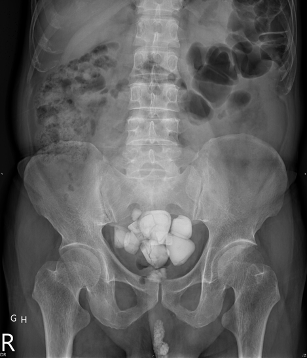巨大膀胱結石同時伴有尿道結石街之罕見案例報告
廖偉創、張彰琦、陳修聖、莊梓昱
臺北市立聯合醫院忠孝院區外科部泌尿科
Large bladder stones with concurrent urethral steinstrasse: A rare case report
Wei-Chuang Liao, Chang-Chi Chang, Shiou-Sheng Chen, Tzu-Yu Chuang
Division of Urology, Department of Surgery, Taipei City Hospital, Zhongxiao Branch
Introduction
Urethral calculi represent 1-2% of all calculi in the genitourinary tract. Bladder stones have multifactorial etiologies, commonly associated with urinary infections, urinary stasis and bladder outlet obstruction. Primary urethral calculi are commonly developed due to urethral stricture, posterior urethral valve, or diverticulum. We reported a rare case of large bladder stones coexisting with urethral steinstrasse, causing acute urine retention.
Case presentation
A 69-year-old man with medical history of benign prostate enlargement presented to the emergency department due to acute urine retention, and suprapubic pain for two days. He endorsed operation history of left inguinal hernia undergoing surgical management 3 years ago, and endoscopic cystolitholapaxy 7 years ago. Suprapubic bladder catheter was placed based on massive urine amount in ultrasound view, and he was referred to urologic clinic. The Kidney-Ureter-Bladder (KUB) X-ray showed multiple radiopaque densities in pelvic cavity and infrapubic region (Fig. 1). Physical examination revealed palpable solid masses along the penile urethra. Digital rectal examination revealed a diffusely rubber prostate with smooth contour. Transrectal ultrasonography demonstrated a volume of 31.18 ml and multiple calcified spots. The patient subsequently underwent Multipulse laser vaporesection of prostate and laser lithotripsy of multiple large bladder stones and urethral stone steinstrasse. The fragmented stones were washed out via cystoscopic sheath and removed by a grasper. He was discharged after removal of the urinary catheter. At 3-month follow-up, the patient had smooth urination without urinary frequency or dysuria. The postvoid residual (PVR) measured 43 ml.
Conclusion
Steinstrasse is a rare complication most commonly found after extracorporeal shock wave lithotripsy for renal stones. Primary urethral steinstrasse are extremely rare condition in men. In this case, huge bladder calculi and urethral stone steinstrasse were found in initial diagnosis. Ureteroscopic laser lithotripsy was used to disintegrate urethral calculi and move fragmented stones back into the bladder. After laser cystolithotripsy and complete removal of the stones, we performed Multipulse laser vaporesection of prostate to relieve prostatic urethral obstruction.

Fig. 1 KUB showed large burden of bladder stones and urethral
stone steinstrasse.